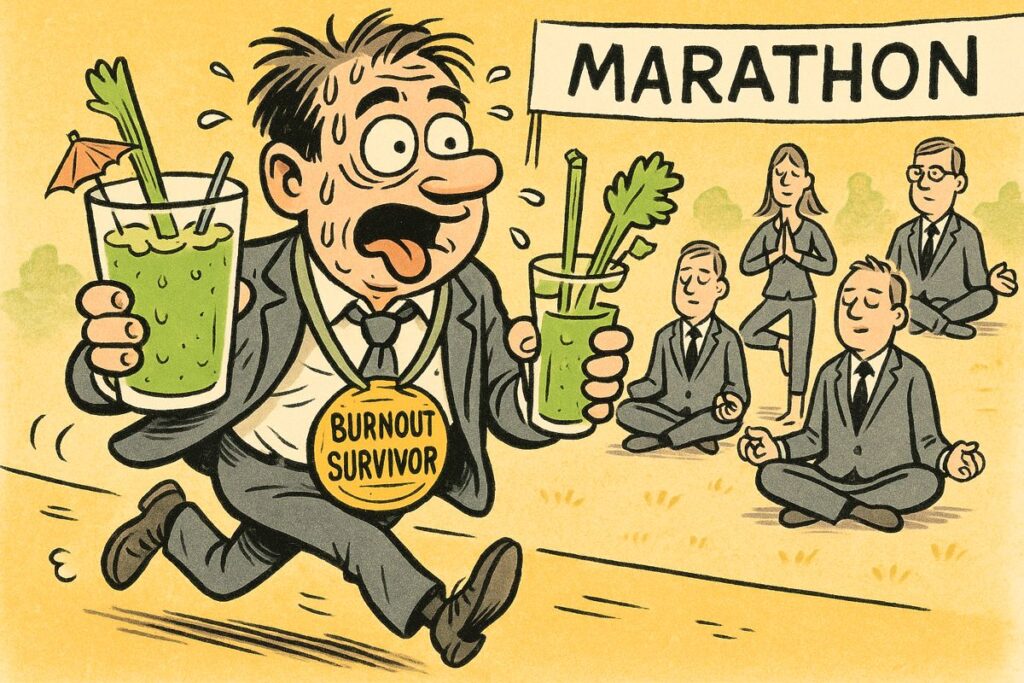Executive Burnout: A Major Business Risk
The executive landscape is in flux. In 2024, burnout among CEOs and senior leaders has reached an inflection point. Over half of executives now report sustained symptoms of burnout, and organizations are feeling the impact – nearly half have lost critical leadership to stress and exhaustion. In healthcare, three out of four executives describe their stress as extreme. For leaders logging over 62 hours a week on less than six hours of sleep per night, the opportunity cost is staggering: burnout is not a personal health issue alone – it’s a strategic threat, costing organizations upwards of $322 billion annually in lost productivity. The problem is most acute among younger leaders, with burnout now peaking at just 25 years old for Gen Z and millennials.
The Athletic Paradigm: CEOs as Corporate Athletes
Today’s most forward-thinking CEOs are abandoning the outdated “always-on” approach. Instead, they’re modeling their routines after high-performance athletes, whose careers depend on repeatable, sustainable excellence. Routines now pivot on structured recovery, mindful presence, and physical challenge. As McKinsey CEO Bob Sternfels notes, the modern leader must cultivate “new habits of mind, body, and spirit” – mirroring the holistic playbook of championship athletes.
Recovery as a Strategic Investment
Just as elite athletes schedule deliberate recovery to maintain their edge, savvy executives are building in rest periods, exercise, and quality sleep. Viewing leadership as a series of sprints and strategic pauses – instead of a never-ending marathon – unlocks what I call the “focus premium.” Practices like walking meetings not only break traditional silos but also inject movement and transparency into the workday.
Mindfulness: The ROI of Mental Clarity
Meditation, breathwork, and mindfulness are now standard performance drivers at the top tier. These tools sharpen mental clarity, mitigate stress, and turbocharge decision-making – the same cognitive resilience that separates all-star athletes from the rest. Sternfels’ embrace of humor, connection, and small team walks further strengthens trust and team resilience, compounding the performance dividend.
Sober-Friendly Leadership: Optimizing for Focus and Longevity
Perhaps the most transformative shift is away from alcohol-centric socializing. Today’s executives are minimizing alcohol consumption, channeling their energy into physical challenges and wellness-focused networking. Sober-friendly events and retreats are now status quo. From a performance strategy perspective, the calculus is clear: alcohol’s hidden costs – lost time, diminished focus, eroded judgment – are now seen as direct hits to sustainable leadership. Research underscores that lasting change, much like athletic excellence, is about rewiring behavior and mindset, not white-knuckle willpower. Effective transformation demands structure, mindfulness, and positive goal-setting – reinforcing new neural pathways over two to three years, with patience and consistency as the non-negotiables.
Gender, Remote Work, and the Organizational Balance Sheet
Burnout’s impact is uneven: women executives now report far higher rates of exhaustion than men, with the disparity more than doubling since 2019. Meanwhile, remote work – contrary to expectation – has heightened burnout risk by 20%, highlighting the need for clearly defined boundaries between work and recovery. The case for urgent action is overwhelming: over 90% of healthcare executives believe burnout is directly undermining organizational performance and outcomes.
High-Performance Leadership: The Next Evolution
A new leadership archetype is emerging. The era of the tireless, always-on executive is yielding to a performance model rooted in athletic science: strategic rest, mindful self-awareness, physical wellness, and sober-friendly routines that enhance clarity and resilience. This is no longer a matter of individual well-being – it’s a core business value, reshaping the future of organizational leadership. The sustainable leader of tomorrow will operate not as a corporate machine, but as an elite performer: balanced, focused, and built for enduring impact.
Self-Reflection Prompt:
What is your hidden opportunity cost – the routines, habits, or default choices that silently sap your focus premium and long-term performance?



